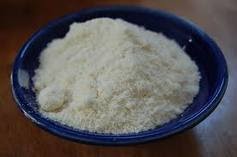
The following is a guest blog post from Dawn Marie Black, a woman with PCOS. Dawn is learning to cook in hormone-friendly ways, and has a great blog, Much Madness Is Divinest Sense, in which she records her experiences on this journey. In this post Dawn shares information about coconut flour.
If you'd like to try coconut flour but cannot find it locally, here are some options for online ordering.
What flour is high in fiber, and protein, low in carbohydrates and gluten free? We're talkin' coconut flour here!
I have PCOS, and found that these things are better for me, and having tried this flour I found I really like it.
Coconut flour is fiber from the coconut meat after most of the oil has been extracted to make Virgin Coconut Oil. Each brand of coconut flour will vary in their content of protein and fiber, but the protein and fiber is higher than gluten based flours, and that makes this flour very appealing for keeping my baked goods low carb, and to reduce other gastric issues that gluten can aggravate. Who really likes having IBS issues? I, for one, am not a fan. It is also considered a hypoallergenic food since so few people are allergic to coconut, which makes this easy to offer to many of your friends who may have other allergies. There are three things to remember when using coconut flour: One, always sift. Two, extra liquid is needed. Three, it needs something to bind it all together.
Coconut flour can be used in all recipes calling for flour. Most can be substituted with anywhere between 10% — 30% coconut flour, adding in the equal amount of liquid into the recipe as well. Other recipes may need further adjustments, for binding agents and liquid depending on the amount of fiber in the coconut flour. The easiest recipes to convert to 100% coconut flour are muffins, bars, pancakes, cakes, and quick breads. There are recipes on the internet and in print that can be helpful in building new recipes from. I have tried doing an equal exchange of flour, and without the extra binding agents and liquid the muffins were really dry, enough to toss with one bite. It was awful. If it looks dry, add more liquid.
There are several things to remember when using coconut flour. Always sift before measuring whether the recipe calls for it or not, it is inferred. If you forget to sift, you will be disappointed with your results as it will be dry and crumbly. This flour is very"thirsty", the fiber in the flour soaks up moisture, so more needs to be added to your recipes, it's usually an equal amount. Sticky sweeteners, such as brown rice syrup, can be included in your measurements for liquid, but oil is not included. Then you'll want to remember that since the flour has no internal binder, it requires additional eggs. The ratio is between 4-5 eggs per cup up to 1 egg per ounce of flour, there are other binders that can be utilized as well, egg whites, soaked flax, sticky sweeteners help with binding as well. I have found that those who are cooking vegan know many other binding agents and are good sources to ask regarding other alternatives in your baking. I've compiled a list of alternatives you can find by clicking here. I personally like eggs, they provide protein and are tasty, but I do substitute egg whites for some of the eggs, especially when I know I will be eating them in other forms through out the day.
If your batter is dry your baked goods will be dry, add in more liquids to moisten the flour for a more moist baked item. I forgot this once with a quick bread recipe, the batter was dry, and when the bread came out of the oven it was more lumpy and dry then when I had put it in the oven. Do not be afraid of a more moist batter, the fiber soaks it up. Coconut flour can be used in other common purposes such as breading and as a thickening agent for soups, stews, etc. If you are using it as a breading, make double the sauce to pour over your item in order to allow for the soaking up of the liquids. I made a Coq a Vin for a party, and overnight the breaded chicken soaked up all the sauce that was to be poured over the pieces of chicken. The flavor was there, but it would have been more delicious with the sauce to pour over the meal. Do not be afraid to make adjustments, print out your recipes make notes with your changes, decide how you liked your item and either make more corrections or make a note letting yourself know if you liked it or not. There will be some things that you will love the flavor, but maybe you will want a different texture. I'm still working on gooey brownies, I will be adding apple sauce to increase the moisture in my next batch.
Here are some helpful links to find recipes to begin your journey of cooking with coconut flour, and don't forget these three things when using coconut flour: always sift before measuring, extra liquid is needed, and it needs something to bind it all together.
http://www.freecoconutrecipes.com/gluten_free_coconut_flour_recipes.htm
http://www.kokonutpacific.com.au/OilSales/OilIndex.html?Health/CoconutFlour.php
http://www.simplycoconut.com/coconut_flour.htm
http://www.tiana-coconut.com/coconut_flour_recipes.htm